Introduction:
Just don’t ask…
About Cattle
Domesticated cattle (B. Taurus).
Height of 150 cm (59″), and weigh 410-910 kg (900-2,000 lbs.). Eat 70 kg (155 lbs) of green grass a day Eat 1.4 kg (3 lbs) of silage or .45 kg (1 lb) of hay for every 100 lbs of body weight. Lactating cows require an additional .45 kg (1 lb) of grain or feed for every 3 lbs of milk it produces
[2.7-4.4 gallons per day. Milk weighs 3.9 kg (8.6 lbs) per gallon].
Cattle were raised principally in history for either milk production or for muscle. Beef and leather are byproducts of an animal that has either died or is somehow otherwise surplus.
“Just how big were cattle in the Middle Ages anyway?”
To determine size, we look at two standards. The height to the top of the shoulder (aka the whithers), and/or the weight. This information will be given in the following manner: [female cm (in.); kg (lbs)/male cm (in.); kg (lbs)]
- Postglacial Aurochs (Bos Primigenius)
[147 cm (57.9″)/157 cm (61.8″) or 150 cm/180 cm] - Neolithic Domestic (c2600 BCE)
[Longhorns]
[125 cm (49″)] - Late Neolithic, Beaker, and Early Bronze Age (c1900 BCE)
[122 cm (48″)] - Middle Bronze Age (1000 BCE)
[109 cm (43″)] - Iron Age (300 BCE)
[107 cm (42″)] - Romano-British (1st -4th C)
[112 cm (44″)] - Anglo-Saxon & Scandinavian (7th-10th C)
[115 cm (45.3″) or 104.6-121.4 cm (40.9″-47.8″)] - Saxo-Norman and High Medieval (11th-13th C)
[110 cm (43.3″) or 100-130 cm (39.4-51.2″)] - Later Medieval (14th-15th C)
[109 cm (42.9″)] - Tudor (late 15th-16th C)
[120 cm (47.2″)] - 18th C
[138 cm (54.3″)] - Modern English Longhorn
[130-140 cm (51″-55″)/150 cm (59″)] - Modern Dexter
[91.4-106.7 cm (36″-42″)/96.5-111.76 cm (38″-44″)] - Greenlander (extinct)
[100-110 cm (39.4″-43.3″)]
Therefore, in Britain, at least, cattle in the Middle Ages were smaller than the “average” modern cattle (I *think* 110 cm: 150 cm is about 73% and about 3.6″). On the other hand, the different breeds can give you a different idea of what an average Bovine should look like.
“What Breeds existed in the Middle Ages, and would that have an effect on the statistics?”
Most breeds of cattle can not be dated accurately before the 1700s, so it may be difficult to determine what breeds existed then. Let’s look at some breeds assumed to have existed before the 17th century.
- Alderney
Channel Islands – Extinct. - “Alpine”/Swiss Brown
Brown Cow from the Lower Alps in Switzerland and Germany. May stretch back to one of the oldest cattle breeds. Large. Work/Milk.
[130 cm (51″); 636 kg (1,400 lbs)/145 cm (57”); 909 kg (2000 lbs)] - Aurochs (Bos Primigenius, auerochse, ur, boeuf sauvage, oeros, oerrund)
Extinct, with the last being killed in a Polish forest in 1627. There are modern “bred back” recreations. A second shorthorned species was also described (B. Longifrons or Brachyceros) from which many modern shorthorned breeds are thought to descend, although some people think that this shorthorned breed may be just the female Aurochs.
[147 cm (57.9″)/157 cm (61.8″) or 150 cm/180 cm] (n.b. The modern humped cattle are alleged to derive from Bos Indicus or B. Namadicus, now extinct) - British (“Park”) White (or White Park, Ancient White Park, White Forest, White Horned, Wild White)
England. Medium (or Small) and Shaggy. Longhorns and polled varieties exist. White fur with black points. The Chillingham Park herd allegedly has not had any interbreeding with other herds since 1220/50. Genetically related to the Galloway and Highland.
[636 kg (1,400 lbs)/954.4 kg (2,100 lbs)] depending on your sources. Others place the Chillingham herd at
[386.4 kg (850 lbs)/454.5 kg (1000 lbs)] Other herds are at Cadzow, Chartley, Vaynol. (NOTE: Do not confuse with the British White (aka, the “Polled Park White”), which is an entirely different Breed, although may be decended from the Park White). - Canadienne
France, related to the Normande, Jersey, and Alderney cattle, these milk producers were imported in 1541 to Quebec by Cartier. Milk.
[122 cm (48″); 550 kg (1,210 lbs)/137 cm (54″); 813 kg (1,790 lbs)] - “Celtic” Black
Britain (from which the Welsh Black, the Galloway, the Highland, and the Angus may have derived).
[110 cm/120 cm] - Corriente
Spain, imported to the New World by the Spaniards in the 15th and 16th centuries, their descendants remain in Northern Mexico, and are the also ancestral to the Texas Longhorn
[99 cm (39″); 363 kg (800 lbs)/99 cm (39″); 454.5 kg (1000 lbs)] - Galloway
Scotland (SW Islands) – May be the southern Scots polled cattle referred to since the 11th Century, they may only be 18th Century when the first solid records of them reach back to.
[122 cm (48″); 575 kg (1,265 lbs)/137 cm (54″); 813 kg (1,790 lbs)] - Greenland
Extinct. Known only from archarological remains. Decended from Norwegian cattle (see “Norsecattle”). Milk
[Size based on bones: 100-110 cm] - Guernsey
Channel Islands – The Guernsey began c1000 when monks imported cattle from France. - Highland
Scotland (NW Islands) – Medium. Although cattle similar to this have been mentioned in records since the 12th Century, and some scholars place them back to the Iron Age, they may only be 17th Century when the first solid records of them reach back to.
[107 cm (42″); 363.6-454.5 kg (800-1000 lbs)/122 cm (48″); 454.5-590.9 kg (1000-1300 lbs)] - Icelandic
Decended from Norwegian cattle (see Norsecattle”). Small. Milk (long body/short legs)
[340.9-500 kg (750-1100 lbs)/454.5-772.7 kg (1000-1700 lbs)] - Longhorn
England (uplands). Large.
[130-140 cm (51″-55″); 500-600 kg (1000-1320 lbs)/150 cm (59″); 1000 kg (2200 lbs)] - Maol
Ireland. Extinct? “Hornless” Medium size? Work.
[636kg (1400 lbs)/909 kg (2000 lbs)] - Marchigiana
Italy (Near Rome) Large. Work. Almost pure “Italian Podolian”, or Russian steppes cattle, brought to Italy in the 5th Century. May be ancestral to the Chianina.
[590.9-691.8 kg (1300-1500 lbs)/909 kg (2000 lbs)] - “Viking Cow”/Norsecattle (North Finncattle/Mountain cattle (Fjallko)/Blacksided Trondor) – Finland, Sweden, Norway. (Long body/short legs) Small. Milk. Seems to be related (if not ancestral) to a number of other cattle types in Europe.
- Norwegeian Blacksided Trondor
[318-409 kg (700-900 lbs)/636 -772.7 kg (1400-1700 lbs). - Swedish Mountain cattle
[318-409 kg (700-900 lbs)/454.5-613.6 kg (1000-1350 lbs)
- Norwegeian Blacksided Trondor
- Romagnola
Italy (Lower Po) Very Large. Work. Almost pure “Italian Podolian”, or Russian steppes cattle.
[656-795.5 kg (1450-1750 lbs)/1156 kg (2500 lbs)] - Shorthorn
England (NE lowlands)
[12 cm (48″); 590.9-636 kg (1300-1400 lbs)/137 cm (54″); 909 kg (2000 lbs)] Originate from the shorthorned:- Holderness
- Teeswater (also partially ancestral to the Ayrshire).
Other English Shorthorned Cattle:
- Devon
England. An ancient Red shorthorned breed typical of those found all over southern England. May be descended from B. Longifrons. Work.
[122 cm (48″); 431.8-590.9 kg (950-1,300 lbs)/137 cm (54 cm); 772.7-1000 kg (1700-2200 lbs) - Hereford
England. An ancient Red shorthorned breed typical of those found all over southern England. - Lincoln Red
Bred from the local Shorthorned Red stock with the “Norsecattle” in the 8th-10th centuries. - Norfolk
A small, hardy, beefy Red cow. - Suffolk
A large dun colored dairy cow (possibly decended from a Galloway related breed, crossed with the - Sussex
England. An ancient Red shorthorned breed typical of those found all over southern England. Reported as a draft ox as far back as 1066. Work.
[137 cm (54″); 590.9 kg (1,300 lbs)/145 cm (57 cm); 1000 kg (2200 lbs)]
- Welsh Black (Gwartheg Duon Cymneig)
Wales. Now Medium sized. Historically, the Northern black was considerably smaller. May only be as old as the 17th Century.
[122 cm (48″); 454.5 kg (1000 lbs)/137 cm (54″); 863.6 kg (1900 lbs)]- Anglesy
Small. Long, beefy body. - Pembroken
Medium. Milk.
- Anglesy
- Wisent/Bison
Bulgaria, Romania
[170-180 cm (66.9″-70.9″); 726-910 kg (1,600-2,000 lbs)]
Others
- Whitefaced redbodied
Holland. - Red-and-white
Sweden/Denmark. - Danish Red
Denmark. Descended from the old German Angln, local island cattle, and the Bally. - Black and white
Jutland. - Black and white
N. Netherlands. These pre-17th Century proto-Holsteins are known to exist from records. - Belted black and white
Netherlands. The pre-17th Century cattle appear in early paintings. - Fromont du Leon
France. ??? - Norman Brindle
France. ??? - Golden, Long legged cattle from the valleys
Italy - Red-to-Straw colored Mountain cattle
Italy
“Are there any other modern breeds that might have remained unchanged from the Middle Ages?”
The following breeds appear or claim to be pre-17th century “landraces”.
- Alentejana
Portugal. Large. Work
[545.5 kg (1200 lbs)/818.2 kg (1800 lbs)] - Brittainy Black Spotted
France. Small. Once work, now milk.
[363.6-409.1 kg (800-900 lbs)/545.5-681.8 (1200-1500 lbs) - Camargue
France (Rhone delta) *Small* Sport and Festival.
[295.5 -341 kg (800-900 lbs)/545.5-681.8 kg (1200-1500 lbs)] - Chianina
Italy (central) Alleged to have existed since Roman times, although this is debateable. EXCEPTIONALLY LARGE Work
[818.2 kg (1800lbs)/upto 1818.2 kg (4000 lbs)]. - Dexter
Ireland (Kerry) *Very Small* May only be 17th Century, or may be from the oldest of breeds
[91.4 cm-106.7 cm (36″-42″); 341 kg (750 lbs)/96.5 cm-111.76 cm (38″-44″); under 454.5 kg (1,000 lbs)]. - Flamande
France. Work/Milk.
[590.0-681.8 kg (1300-1500 lbs)/upto 1136.4 kg (2500 lbs)] - Fresian
Netherlands – *probably* post-1700, descended from Northern Jutland Black-and-White cattle.
[636-681.8 kg/1400-1500 lbs)/1045.5 kg (2300 lbs)] - Grauvia (Grigia Alpina)
Austria, Italy (“Grey cattle” or “Grey Mountain Cattle”) Tyrolian. Some claim to be tracable back to the Romans. Medium to Large. Milk.
[454.5-545.5 kg (1000-1200 - lbs)/681.8-818.2 kg (1500-1800 lbs)]
- Grey Steppe
Romania, Russia?. “Medium Sized”
[454.5 kg (1000 lbs)/636.4-681.8 kg (1400-1500 lbs)] - Hawaiian Wild Cattle
Hawaii – Abandoned by Cook?
[318.2 kg (700)/545.5 lg (1200 lbs)] - Herens (Eringer)
Switzerland. Work/Sport/Milk.
[119 cm (46.9″); 450-500 kg (990-1100 lbs)/122 cm (48″); 600-650 kg (1320-1430 kgs)] - Iskur
Bulgaria. “Medium Sized” Bred from Grey Steppe Cattle, with some northern breed “in the remote past”. Work (some milk).
[454.5 kg (1000 lbs)/636.4-681.8 kg (1400-1500 lbs)] - Kerry
Ireland “Medium” size. Milk. (long body/short legs) May only be 17th Century
[354.5-454.5 kg (780-1000 lbs)] - Longhorned
Texas.
[1430- kg (650-750 lbs)/454.5 kg (upto 1000 lbs)] - Mertolenga
Portugal. Large. Work
[545.5 kg (1200 lbs)/818.2 kg (1800 lbs)] - Modenese
Italy (Lower Po) Very Large. Work.
[659.1-759.5 kg (1450-1750 lbs)/1136.4 kg (2500 lbs)] - Modicana
Italy (Sicily) Introduced by Normans after a plague wiped out the Sicilian cattle. Medium size. Work/Milk.
[409.1-590.9 kg (900-1300 lbs)/454.5-727.3 kg (1000-1600 lbs)] - Murciana
Spain. Work.
[545.5 kg (1200 lbs)/818 kg (1800 lbs)] - Native Cattle
Greece. A Grey Steppe derivative. Very small.
[204.5-272.7 kg (450-600 lbs)/???] - Piedmontese
Italy. Work/Milk. Medium-Large.
[636 kg (1400 lbs)/909 kg (2000 lbs)] - Pirenaica
Spain (Pyrennes). Large. Work/Milk.
[ ???/upto 909 kg (2000 lbs)] - Prete
Italy (Sicily). Small. Some work.
[318-364 kg (700-800 lbs)/ 454.5 kg (1000 lbs)] - Rodopska
Bulgaria. *Small*. Mountain cattle from the south. Look like goats. Work (some milk)
[1760 kg (800 lbs)/1980 kg (900 lbs)] - Norwegian Red
Norway –
[122 cm (48″); 600 kg (1,320 lbs)/137 cm (54″); 1100 kg (2,420 lbs)] An amaglamation of several old local breeds, including:- Dole
- Hedmark
- Hordaland
- Jarlsberg
- Lyngdal
- More
- Ramsdal
- Red Tronheim
- South Norwegian
- Vestland Fjord
- Vestland Red Polled
- West Norwegian
- Polish Red
Poland – Dark Red. Medium to Large. Resembles the German red. Milk.
[;400-500 kg (880-1100 lbs)/500-550 kg (1100-1250 lbs)] - Tarentaise
France Alpine. Medium. First work, now milk.
[590.9 kg (1300 lbs)/upto 1090.9 kg (2400 lbs)] - Telemark
Norway – An amaglamation of several old local breeds. Small. Milk
[400-500 kg (880-1100 lbs)]

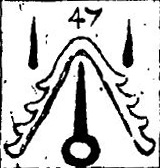 XLVII. He Beareth Gules, a Butcher’s Cambril, Or: between two Seuers, and Raising Prick, Argent. This is born by the name of Buncher.
XLVII. He Beareth Gules, a Butcher’s Cambril, Or: between two Seuers, and Raising Prick, Argent. This is born by the name of Buncher.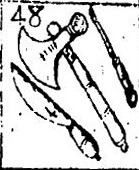 XLVIII He Beareth Azure, a Butcher’s Axe, between his Steel and Knife bendwise, Proper. The Butcher or Slaughter-Man in the slaughter house uses the Axe to strike down Beasts, as Bulls, Cows, Heifers, and Oxen; and by the same instrument doth divide, cut and break their bones; also at the Shambles where they fell their meat both the Axe and the Cleaver are used to cut the Quarter of Beasts into smaller and more vendable pieces.
XLVIII He Beareth Azure, a Butcher’s Axe, between his Steel and Knife bendwise, Proper. The Butcher or Slaughter-Man in the slaughter house uses the Axe to strike down Beasts, as Bulls, Cows, Heifers, and Oxen; and by the same instrument doth divide, cut and break their bones; also at the Shambles where they fell their meat both the Axe and the Cleaver are used to cut the Quarter of Beasts into smaller and more vendable pieces.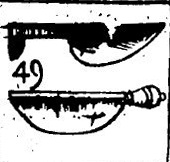 XLIX He Beareth Vert, a Dutch Butcher’s Cleever, and a Chopping Knife; the Chopping Knife is to mince and shred the Flesh off the Bones, small for Pyes and such like use, etc.
XLIX He Beareth Vert, a Dutch Butcher’s Cleever, and a Chopping Knife; the Chopping Knife is to mince and shred the Flesh off the Bones, small for Pyes and such like use, etc.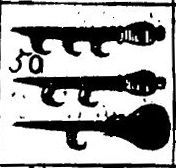 L. He beareth sable, three Punching Hooks in Pale, the haft […], and the third Angle Hooked, proper. By the help of the Punching Hook, the skin is with much ease taken off any beast, by striking and pricking between the Skin or Hide, and the Fleshwhich causeth a separation between them. This is born by the name [But]cher.
L. He beareth sable, three Punching Hooks in Pale, the haft […], and the third Angle Hooked, proper. By the help of the Punching Hook, the skin is with much ease taken off any beast, by striking and pricking between the Skin or Hide, and the Fleshwhich causeth a separation between them. This is born by the name [But]cher.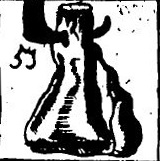 LII. He Beareth Argent, on a Hook issuing out of the Chief; a Leg of Veal proper. Some term it a Leg of Veal or Mutton hung by the ham-string on a hook […] Gules. This is a Cognizance belonging […] and for most Cooks shops […] felt hung in the window, or by its shape and figure in a sign over the door.
LII. He Beareth Argent, on a Hook issuing out of the Chief; a Leg of Veal proper. Some term it a Leg of Veal or Mutton hung by the ham-string on a hook […] Gules. This is a Cognizance belonging […] and for most Cooks shops […] felt hung in the window, or by its shape and figure in a sign over the door.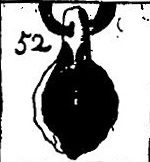 LII. He Beareth Or, a Westphalia Ham, hung in an Iron Staple, proceeding out of Chief, Sable. Some term it an Ham of Pork, or a Leg of Bacon ham-like. The sweetest of Bacons is that which is said to come from Westphalia, because there they are fed with Walnuts and Chestnuts; many of our English Cheats with their feeding of Swine with Pease, Corn and Acorn (to sweeten the flesh) besides their Art used to colour them red, have come very near the Westphalian Ham, both in colour and taste, yet could never attain the full skill, and the reason is very plain; for that as we take Westphalia Bacon, is no other than the Ham of a Cub, or Young Bear, the delicate taste of whose flesh, our Bacon cannot attain unto by any Art.
LII. He Beareth Or, a Westphalia Ham, hung in an Iron Staple, proceeding out of Chief, Sable. Some term it an Ham of Pork, or a Leg of Bacon ham-like. The sweetest of Bacons is that which is said to come from Westphalia, because there they are fed with Walnuts and Chestnuts; many of our English Cheats with their feeding of Swine with Pease, Corn and Acorn (to sweeten the flesh) besides their Art used to colour them red, have come very near the Westphalian Ham, both in colour and taste, yet could never attain the full skill, and the reason is very plain; for that as we take Westphalia Bacon, is no other than the Ham of a Cub, or Young Bear, the delicate taste of whose flesh, our Bacon cannot attain unto by any Art.

